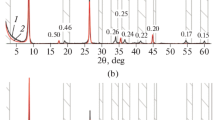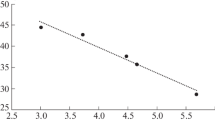Summary
Fresh casts were collected from the earthworm species Aporrectodea caliginosa, and artificial casts were also made. The casts were subjected to ageing, drying-rewetting, and sterilization by hexanol vapour. Clay dispersion was determined, as a measure of the lack of stability of the casts. Two soils were used, the topsoil of a recently reclaimed polder soil in the Netherlands and the topsoil from a South Australian duplex soil. For both soils the fresh worm casts had higher dispersible clay than the artificial casts. During ageing, both types of casts became more stable. There are strong indications that this was mainly due to changes on the surface of the casts. Fungi developed on the surface of 6-day-old worm casts made of Australian soil. This gave a higher stability to the casts compared to artificial casts of the same age without fungal growth. With both types of casts, hexanol inhibited fungal growth on the surface of the casts, reducing the stabilizing effect of ageing. The fungus did not develop on Dutch soil casts until after 42 days, and the development of a higher stability with age was also less marked than in the Australian soil. When the casts were subjected to a drying and rewetting cycle before analysis, they became much more stable than the casts that were analyzed wet. The drying-rewetting cycle removed most of the differences between the worm casts and the artificial casts, and also removed any effects of ageing.
Similar content being viewed by others
References
Arya LM, Blake GR (1979) Stabilization of newly formed soil aggregates. Agron J 64:177–179
Aspiras RB, Allen ON, Chesters G, Harris RF (1971) Chemical and physical stability of microbially stabilized aggregates. Soil Sci Soc Am Proc 35:283–286
Barois I (1987) Interactions entre les Vers de terre tropicaux géophages et la microflore pour l'exploitation de la matière organique du sol. Travaux des chercheurs de la station de Lamto no 7
Blake GR, Gilman RD (1970) Thixotropic changes with aging of synthetic soil aggregates. Soil Sci Soc Am Proc 34:561–564
Brady NC (1984) The nature and properties of soils. 9th edn. MacMillan, New York
Dexter AR (1988) Advances in characterization of soil structure. Soil Tillage Res 11:199–238
Dexter AR, Horn R, Kemper WD (1988) Two mechanisms for age-hardening of soil. J Soil Sci 39: 163–175
Emerson WW (1959) The structure of soil crumbs. J Soil Sci 10:235–244
Emerson WW, Foster RC, Oades JM (1986) Organo-mineral complexes in relation to soil aggregation and structure. In: Huang PM, Schnitzer M (eds) Interactions of soil minerals with natural organics and microbes. Soil Sci Soc Am, Spec Publ 17, pp 521–547
Foster RC (1978) Ultramicromorphology of some SOuth Australian soils. In: Emerson WW, Bond RD, Dexter AR (eds) Modification of soil structure. John Wiley and Sons, New York, pp 103–109
Greacen EL (1960) Water content and soil strength. J Soil Sci 11:313–333
Griffith E, Jones D (1965) Microbial aspects of soil structure: 1. Relationships between organic amendments, microbial colonization and changes in aggregate stability. Plant and Soil 23:17–33
Lütjeharms WJ (1952) Soil aggregate stability and wetting resistance as influenced by soil fungi. Pharm Weekbl 87:636–640
McKenzie BM, Dexter AR (1987) Physical properties of casts of the earthworm Aporrectodea rosea. Biol Fertil Soils 5:152–157
Metzger L, Levanon D, Mingelgrin U (1987) The effect of sewage sludge on soil structural stability: Microbial aspects. Soil Sci Soc Am J 51:346–351
Molope MB, Grieve IC, Page ER (1985) Thixotropic changes in the stability of molded soil aggregates. Soil Sci Soc Am J 49:979–983
Molope MB, Grieve IC, Page ER (1987) Contributions by fungi and bacteria to aggregate stability of cultivated soils. J Soil Sci:38: 71–77
Peele TC (1940) Microbial activity in relation to soil aggregation. J Am Soc Agron 32:204–212
Shipitalo MJ, Protz R (1988) Factors influencing the dispersibility of clay in worm casts. Soil Sci Soc Am J 52:764–769
Swaby RJ (1949) The influence of earthworms on soil aggregation. J Soil Sci 1:195–197
Tisdall JM, Oades JM (1982) Organic matter and water stable aggregates in soils. J Soil Sci 33:141–163
Towner GD (1983) Effective stresses in unsaturated soils and their applicability in the theory of critical state mechanics. J Soil Sci 34:429–435
Utomo WH, Dexter AR (1981) Age hardening of agricultural top soils. J Soil Sci 32:335–350
Wace SA, Hignett CT (1988) The effect of rainfall energy on tilled soils of different dispersion characteristics. Proc Symp Soil Management, Sept 1988 Toowoomba, Australia. Australian Society of Soil Science
Author information
Authors and Affiliations
Additional information
Dedicated to the late Prof. Dr. W. Kühnelt
Rights and permissions
About this article
Cite this article
Marinissen, J.C.Y., Dexter, A.R. Mechanisms of stabilization of earthworm casts and artificial casts. Biol Fertil Soils 9, 163–167 (1990). https://doi.org/10.1007/BF00335801
Received:
Issue Date:
DOI: https://doi.org/10.1007/BF00335801




